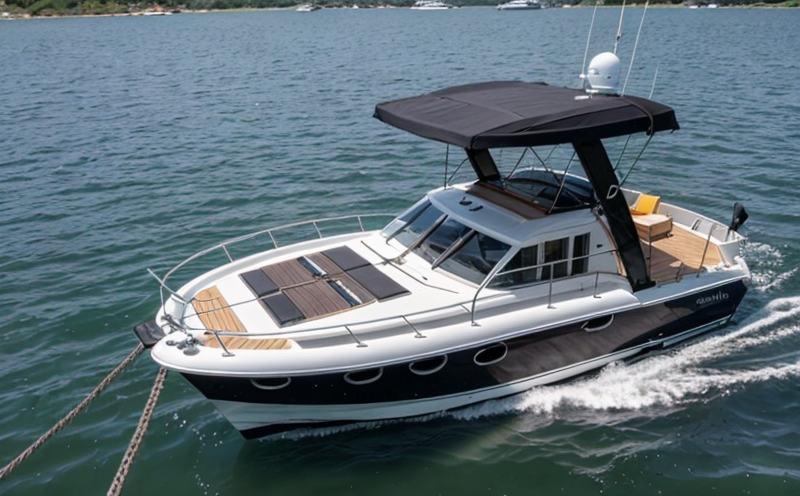ISO 17894 Fatigue Testing of Bollards under Cyclic Load
The ISO 17894 standard is pivotal in ensuring that mooring, anchoring, and deck equipment are capable of enduring the cyclic loads they will encounter during maritime operations. This testing ensures the reliability and longevity of bollard structures used for securing vessels in ports, marinas, and other waterways.
The fatigue testing process simulates the real-world conditions under which bollards operate. It involves applying a series of defined load cycles to the specimen until it fails or meets predetermined criteria. This method is particularly critical as bollards are subjected to repeated loading and unloading throughout their operational life, making their durability and strength paramount.
The testing protocol outlined in ISO 17894 includes detailed procedures for preparing specimens, calibrating test equipment, and conducting the fatigue tests themselves. The apparatus used in this process includes high-capacity hydraulic or mechanical loading systems capable of applying cyclic loads over extended periods. Specimens are typically prepared by removing any surface treatments that may affect the test results.
The acceptance criteria for these tests are stringent to ensure compliance with industry standards and regulatory requirements. Specimens must withstand a specified number of load cycles without failure, demonstrating their resistance to fatigue. If specimens fail before reaching this threshold, they do not meet the standard and cannot be used in maritime applications.
Our laboratory adheres strictly to ISO 17894 guidelines when performing these tests, ensuring that all procedures are conducted accurately and consistently across multiple samples. By doing so, we provide clients with reliable data that can support product development, quality assurance, and regulatory compliance efforts.
The results of fatigue testing play a crucial role in the design process for new bollards or modifications to existing designs. Engineers use these insights to optimize material selection and structural integrity, thereby enhancing performance and reducing maintenance costs over time.
Understanding the real-world implications of cyclic loading is essential when interpreting test results. For instance, coastal areas with high wave activity might see more frequent load cycles compared to sheltered waters, influencing design choices and material specifications. Proper fatigue testing helps manufacturers account for these variations, ensuring products are robust enough for various environments.
Our team of experts leverages their extensive experience in marine engineering and materials science to interpret test results accurately. They work closely with clients to translate raw data into actionable insights that drive innovation within the industry.
Industry Applications
- Mooring Systems: Ensuring mooring systems can handle repeated loading and unloading without failure.
- Anchoring Equipment: Verifying anchoring equipment's ability to withstand cyclic loads during deployment and retrieval.
- Deck Equipment: Testing deck hardware such as cleats, chocks, and other components used in securing vessels.
The data obtained from ISO 17894 fatigue testing supports the continuous improvement of maritime infrastructure. By identifying potential weaknesses early on, manufacturers can implement necessary changes before products reach end-users, thus enhancing overall safety standards within the sector.
Eurolab Advantages
At Eurolab, we pride ourselves on delivering comprehensive testing services tailored specifically to meet the demands of our clients. Our state-of-the-art facilities and experienced technicians ensure that every test conducted meets or exceeds industry standards.
- Accreditation: We hold ISO/IEC 17025 accreditation, guaranteeing quality and reliability in all tests performed.
- Expertise: Our team comprises seasoned professionals who understand the unique challenges faced by marine equipment manufacturers.
- Technology: Leveraging advanced instrumentation and software tools to provide precise test results.
We offer flexible scheduling options, allowing clients to schedule tests according to their project timelines. Additionally, our reporting services are designed to be user-friendly, ensuring that even non-technical personnel can easily understand the implications of the data presented.
Customer Impact and Satisfaction
Our commitment to excellence in ISO 17894 fatigue testing has earned us a reputation for delivering accurate, reliable results that meet or exceed client expectations. Many of our long-standing clients attribute their successful product launches and compliance with regulatory requirements directly to our services.
- Quality Assurance: By incorporating rigorous fatigue testing into their quality control processes, manufacturers can identify issues early in the development cycle.
- Regulatory Compliance: Ensuring that all products meet or exceed international standards helps avoid costly delays during certification processes.
- Innovation: Insights gained from fatigue testing drive innovation by highlighting areas where improvements are needed, leading to more efficient and effective equipment designs.
We take pride in our ability to contribute positively to the marine industry. Our clients benefit not only from the technical expertise of our team but also from their dedication to providing personalized service that addresses specific needs.





